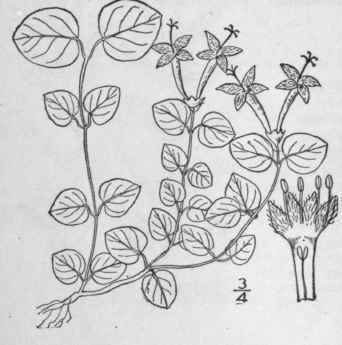4. Mitchella L. Sp. Pl. III. 1753
Description
This section is from the book "An Illustrated Flora Of The Northern United States, Canada And The British Possessions Vol3", by Nathaniel Lord Britton, Addison Brown. Also available from Amazon: An Illustrated Flora of the Northern United States, Canada and the British Possessions. 3 Volume Set..
4. Mitchella L. Sp. Pl. III. 1753
Creeping herbs, with opposite petioled, entire or undulate, evergreen leaves, and white axillary or terminal peduncled geminate dimorphous flowers, their ovaries united. Calyx-tube ovoid, the limb 3-6-lobed (usually 4-lobed). Corolla funnelform, usually 4-lobed, the lobes recurved, bearded on the inner side. Stamens as many as the lobes of the corolla and inserted on its throat; filaments short and style exserted, or filaments exserted and style short. Ovary 4-celled; stigmas 4, short, filiform; ovules 1 in each cavity, erect, anatropous. Fruit composed of 2 united drupes usually containing 8 roundish nutlets. Seed erect; cotyledons short, obtuse; embryo minute. [Named after Dr. John Mitchell, botanist and correspondent of Linnaeus in Virginia.]
Two species, the following typical one North American, the other Japanese.
1. Mitchella Repens L. Partridge-Berry. Twin-Berry
Fig. 3924
Mitchella repens L. Sp. Pl. 11 l. 1753.
Stems slender, trailing, rooting at the nodes, 6'-12' long, branching, glabrous, or very slightly pubescent. Leaves ovate-orbicular, petioled, obtuse at the apex, rounded or somewhat cordate at the base, 3"-10" long, pinnately veined, dark green, shining; peduncles shorter than the leaves, bearing 2 sessile white flowers at the summit; corolla 5"-6" long; drupes red (rarely white), broader than high, 2'-4" in diameter, persistent through the winter, edible.
In woods, Nova Scotia to Florida, west to western Ontario, Minnesota, Arkansas and Texas. April-June, sometimes flowering a second time in the autumn. Hive- or squaw-vine. Checker-berry. Deer-berry. Fox-or box-berry. Partridge-vine. Winter-clover. Chicken-, cow-, pigeon-, snake- or tea-berry. Two-eyed-or one-berry. Squaw-plum. Leaves often whitish-veined; flower-buds pink. Ascends to 5000 ft. in Virginia.

Continue to:


